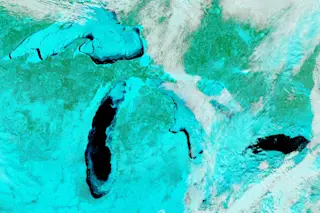A false-color image captured by NASA's Aqua satellite on Feb. 19, 2014, when ice covered 80 percent of the the Great Lakes. This color scheme helps distinguish ice from snow, water, and clouds. Ice appears pale blue. (Source: NASA) If I had to pick a word of the week it would probably be "ice" — an abundance of it in the Great Lakes and a lack up in parts of the Arctic. That icy dichotomy pretty much captures the essence of the strange winter we've been having this winter. The satellite image above, acquired by NASA's Aqua satellite on Feb. 19, shows the Great Lakes in false color (bands 7-2-1 on the MODIS instrument). Ice cover shows up pale blue, open water is navy blue, snow is blue-green, and clouds are white or blue-green. In mid-February, ice cover on the Great Lakes reached 88 percent, according to NASA, well above ...
Ok Arctic, You Can Take Your Ice Back. You Need It Badly.
Discover the unusual winter dynamics with Great Lakes ice cover reaching 88% while Arctic sea ice declines drastically.
More on Discover
Stay Curious
SubscribeTo The Magazine
Save up to 40% off the cover price when you subscribe to Discover magazine.
Subscribe













